“Victor, are you ready to start the engines?” I asked the captain.
“They’re running,” he replied.
I soon discovered that, even under way, the Fleming 78 was so quiet and free of vibration that we had to open the pilothouse door to hear any significant noise — and what we heard was the sweet sound of water, parted by the ship’s bulbous bow, gently flowing aft.
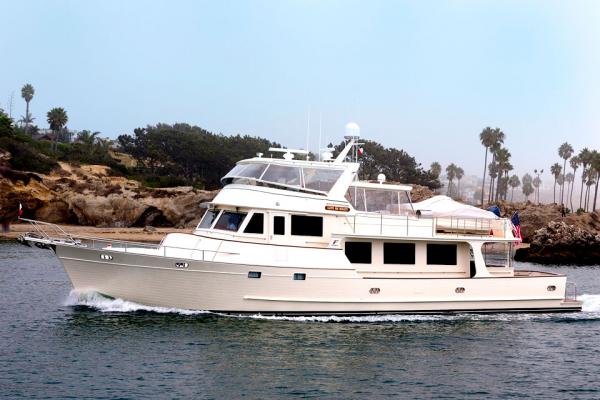
Flemings are known for their whisper-quiet, smooth ride, but the 78 — evolved from the builder’s previous flagship 75-footer — sets new standards in noise suppression. “The owner was very keen that his new Fleming be as quiet as possible,” said Duncan Cowie, the man now running this 25-year-old company, along with engineer Adi Shard, founder Tony Fleming’s nephew. “We installed nearly 100 additional sheets of lead foam insulation throughout the boat.” Bulkheads were thickened to accommodate the extra lead insulation.
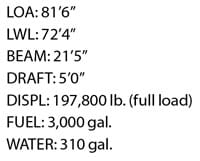
Also contributing to the ship’s quietness are the new V-8 common-rail 1,000-horsepower MAN diesel engines instead of the normally specified 1,550-horsepower MANs. “The owner, a very experienced yachtsman who has owned a Fleming 65 and a much larger expedition-style yacht, prefers cruising in the 8- to 10-knot range, so these engines are ideally matched to this particular 78, providing an especially quiet ride,” Cowie added. An Aquadrive anti-vibration system allows the engines to be soft-mounted, even further reducing noise and vibration.
Cowie told me that the bulbous bow and additional waterline length, created by extending the hull beneath the swim platform, have improved fuel efficiency over the Fleming 75 by 13 percent at 8 knots and 10 percent at 9 knots. “A bulbous bow has an optimum performance range of just plus or minus 3 knots, so this particular bulb design is different from the ones on the next 78s meant to cruise at higher speeds.” Top speed on this 78 is 16.1 knots versus the 22 to 23 knots projected for the more powerful standard models.
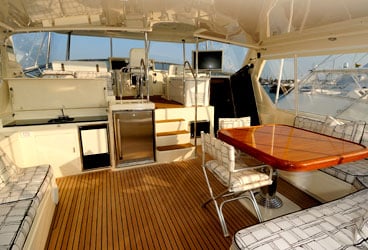
This yacht’s solid fiberglass hull is hand-laid and reinforced with interlocking frames and full-length stringers for superior stiffness and strength. Having fallen off breaking seas into 20-foot troughs while accompanying Tony Fleming aboard his Fleming 65 during a voyage to Iceland, I can attest to the integrity of the builder’s robust construction.
Vinylester resins, first used by Fleming below the waterline to resist osmotic blistering, are now used throughout, eliminating fabric print-through and creating an excellent fiberglass finish. Indeed, the new 78 will turn heads with her traditional good looks. Even with a dual-level flying bridge, she has a relatively low profile, a longtime signature of the brand.
Setting her apart from her smaller siblings is the fact that the 78 provides private accommodations for the crew. The area includes a double and single berth, a large head with shower and a seating area with desk. A microwave, refrigerator and TV provide the captain with comfortable quarters, and the ship’s monitoring system allows him to keep tabs on the yacht when he isn’t at the helm.
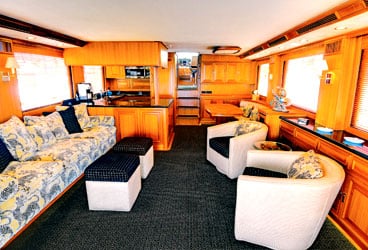
The degree to which the yard will accommodate special requests and custom touches is evident in this 78. First, the owner chose not to have access to the master stateroom from the main salon, but only from the pilothouse’s spiral stairway. Subsequent 78s will have the standard straight stairway from the starboard side of the main salon. Second, traditional V-berths, instead of a centerline island berth, in the forward guest stateroom give the cabin more floor space — room to stand and dress — and an increase in flexibility when friends and family cruise aboard. This cabin has its own head and shower. A second guest stateroom features twin berths, plus a private head and shower. Additional sound-deadening material, extra-thick bulkheads and a full-width fuel tank between the machinery space and the living area turn each stateroom into a quiet sanctuary.
In the tradition of a shore-side family room, the spacious salon features a dedicated dining area adjacent to the fully equipped galley. This particular yacht had an amazing array of home-theater and satellite TV components, so if the guests do not want to watch what is playing on the big screen, they can retire to their staterooms or to the flying bridge and watch a program of their choosing on a TV monitor fed by an individual satellite receiver.
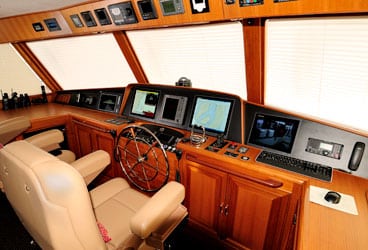
Like all Flemings, the 78 boasts a true pilothouse separated from the main living area, a feature that speaks to the serious voyager and sets her apart from a number of her competitors. The captain and navigator will appreciate the twin Stidd helm chairs, large and easy-to-reach electronics console, generous chart workspace and easy-access electrical panels. A peek behind these panels reveals properly harnessed and identified wiring runs and meticulously dressed connections. A day-head, a settee with a dining table and a drop-down pilot berth allow the on-watch crew to tend to business without disturbing those who are off-watch in the salon, galley or staterooms.
This well-thought-out flexibility extends to the outdoors. The dual-level flying bridge provides an upper helm, which features an electrically operated electronics console that can be lowered when the boat’s in port and the focus is on R&R. Her centerline helm is properly elevated to allow good forward vision, and there is a forward-facing double seat on each side of the helm chair, ideal for those who want to join the captain while the yacht is under way. An adjustable double-lounge platform is positioned across from the outdoor widescreen TV.
Four steps down, the lower bridge sports a wet bar, barbecue grill, refrigerator, ice maker, dining table and settee. A hardtop and glass curtains protect both the upper and lower bridge areas. Aft is the boat deck where the owner’s Boston Whaler is stowed, and where an additional control station provides excellent visibility when backing into a slip.
Below, abaft the entrance to the main salon, a protected lower deck area with dining table and settee gives guests an ideal place to gather and watch the world go by. All of these areas, each on a separate level, make it possible for guests and family to find their own space during long cruises. If one just wants to get away from the crowd or conversation, they’ll find plenty of areas to do so.
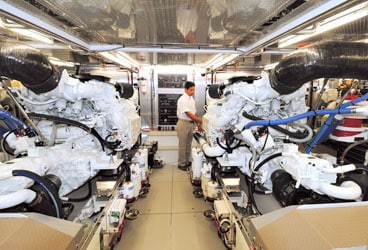
Beyond all the comfort, luxury and beauty of the Fleming 78 is an engineering masterpiece. A leisurely walk around the engine room — yes, you can actually walk around in there — revealed the company’s obsession with locating and installing fuel filters, valves, pumps, engine inspection points, hydraulics — every part and system that’s critical to the yacht’s operation — for easy inspection and service. There’s even a separate machinery room where key electrical components, air-conditioning compressors and a second watermaker are located. Keeping a close eye on these systems as well as the status of tank levels, water pressure, fluid temperatures and more is a Böning ship monitoring system. With 15-inch monitors in the pilothouse, flying bridge and crew quarters, the captain can flip through pages of data displayed graphically and view images from any one of several CCTV cameras throughout the yacht.
Superb aesthetics. Robust construction. Flexible accommodations. Intelligent engineering. This new 78 has all the traits of the highly regarded Fleming line of motoryachts, which include the 55, 65 and soon-to-be-launched 58.
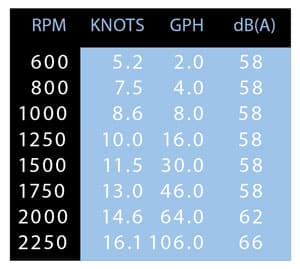
TEST CONDITIONS: Speeds were measured by GPS in the Pacific Ocean off Newport Beach, California, in flat seas and light winds, with a full load of fuel two-thirds load of water and three people on board. Fuel consumption was calculated by the electronic engine-monitoring system. Sound levels were measured in the pilothouse with all exterior doors and windows closed.
Fleming Yachts, 949-645-1024; flemingyachts.com
All photos courtesy of Fleming Yachts.









